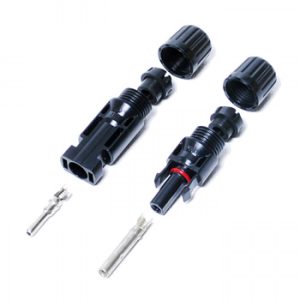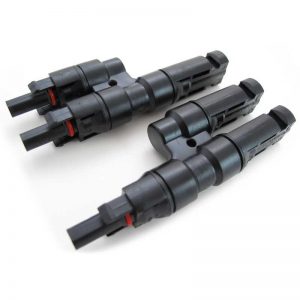Some Hints & Tips on setting up Kit for your Camper
Connecting Solar Panels to a System
The most common connection by far when connecting a Solar Panel to cabling that ends up ultimately at the battery is the MC4 Connector. This is generally a very reliable connector. There is a school of thought that recommends removing these and having a direct connection to reduce inherent losses due to connectors, and there is some merit to that, but I think the losses are very minimal and the convenience of being able to install, uninstall, adapt and adjust Solar Panels by keeping these MC4 connectors in place far outweighs the negatives.
Please Note: The content here is provided as general advice and information and is not specific to YOU or YOUR vehicle.
It should be used at your risk, is not warranted or guaranteed in any way and we are not liable for any losses or damage that might occur.
If this is not acceptable to you and you do not agree to this, do not read any further.
The MC4 Connector – Let’s get one thing straight
There are basically two MC4 Connectors – a male and female (or a plug and socket – use whichever term you prefer. I am going to use both).
The male plug has a red band on it and is marked with a “+” symbol. The female socket is marked with a “-” symbol. BUT … take no notice of that! Whether an MC4 connector carries a +ve circuit or a -ve circuit is not dependant on the style of connector. It is 100% guaranteed that on ANY installation using MC4 connectors, both the male “+” and female “-” will be used on BOTH +ve and -ve circuits.
The Connector itself
As mentioned, there are two different connectors, and they work by mating directly together (which is of course the reason why both are always going to be used on +ve and -ve cables).

In the image here, you see the Female/Socket on the left and the Male/Plug (with the red band) on the right.
The metal pin in front of the connector is crimped on to the cable and is inserted into the connector. A key point to be aware of is the pin for the male connector is LARGER then the one for the female.
It is very easy to assume the reverse and mix them up – and once the pin is inserted into the connector body it is very hard (by design) to remove it and the chances are you would need chop off the connectors you have just fitted and start again with new ones.
+ve or -ve?
I said that the connectors have a + or a – stamped on them. I recommend you do not think of them as a +ve or a -ve connector ever. It will lead to the incorrect connectors being fitted and even more confusion down the line.
A typical solar panel has a +ve and a -ve connection out of it on a couple of short leads. The MC4 connector on the end of the +ve cable out of a solar panel is the Male Plug; the -ve cable will end with a Female Socket. That is the standard and should be adhered to to make any future changes or updates “plug & play”.
This means that the POSITIVE extension cable that goes from the Panels +ve Lead to the Solar Controller is fitted with a FEMALE Socket, and the NEGATIVE extension cable is fitted with a MALE plug (now you see why you ignore the “+” and “-” symbols!)
Series? Parallel? What?
If you have more than one Solar Panel, then you will need to connect them together so you end up with just the one pair of cables going down to the Controller (there are some rare exceptions , but we are talking typical setups here).
I am not going to get into the pros and cons of Serial vs Parallel here – that is a whole different discussion, but I will explain how you cable for each and when you MUST chose one over the other.
Let’s take a setup with 2 panels that must be connected together. We’ll call the panels A and B …
A Series connection involves taking the +ve lead from one panel and connecting it to the -ve lead of the other. You do this simply by connecting the Male MC4 connector from the Panel A +ve Lead to the Female MC4 connector from Panel Bs -ve lead. You then connect the -ve Lead from Panel A to an extension cable, the +ve Lead from Panel B to another extension cable and the pair go down to the Controller.
A Parallel connection is slightly more complex in that you need to buy some more parts. You can get MC4 Splitters or Combiners (they are just different names for the identical things) that allow you to connect all the +ves from multiple panels together, and then connect to a single +ve extension lead, and the same with the -ves.

The image here shows a Combiner (or Splitter) set for connecting 2 panels together.
It has on one of the Pair of MC4 Combiners 2 Male Plugs and one Female; and on the other of the pair the reverse – 2 Female Sockets and one Male
When must you choose Series or Parallel?
As I said, not going to go into the Pros and Cons of either, but there are some circumstances where the choice is out of your hands. This is usually the case where you have a Solar Controller that has a maximum voltage limitation and will be damaged if it is exceeded. The typical Solar Panel that gets installed on a Motorhome or especially a Campervan is a “12V panel”. Confusingly a 12v panel has a maximum voltage around 20-23V. When you connect two panels in series, the effect is to add the voltages together – so if you connect two “12V” panels together, you create a “24V” (“12V” + “12V”) Panel – and that “24V” panel has a voltage around 40-46V.
A good Solar Controller such as a Victron MPPT will not have an issue. For example a Victron MPPT 100/20 can accept a voltage upto 100V – so you could have 4 in series and still be fine. Many cheap basic controllers are limited to just working with “12V” panels and have a much lower tolerance of around 25V or so. For Controllers like those, you MUST connect in Parallel. Most combination B2B/MPPT Charger-Controllers have a similar limit.
When you do a parallel connection of two identical panels, the voltage stays the same, but the current goes up instead. You then have to consider if the cabling you are using is thick enough for the increased current (chances are it is, but it is a consideration).
At the end of the day, it is important to check the technical specifications of the system components – Panels, Controller and Cabling – to work out the best way to configure.
Controllers? I have a 12V Battery, why can’t I just connect a 12V Panel to it?
As I mentioned just now, a “12V” Panel does NOT run at 12V – it goes anywhere between 17V and 23V depending what is going on. Even at the lower end, the voltage is way to high to safely connect to a Battery without causing some damage and shortening its life.
You need a ‘Solar Controller’ which in the most basic terms reduces the voltage from the high panel voltage to a voltage level the battery is comfortable with. Obviously the controllers do other things and the better the controller the more it can do and the more you will gain from the Solar Panel.
The two (+ve & -ve) extension cables from the panel come down to the Solar Controller into the solar panel input (often labeled “PV”). There is then a second pair of terminals that go to to the Battery.
So that is basically the cabling from Panel to Battery in simple terms. I hope this was of some use.
